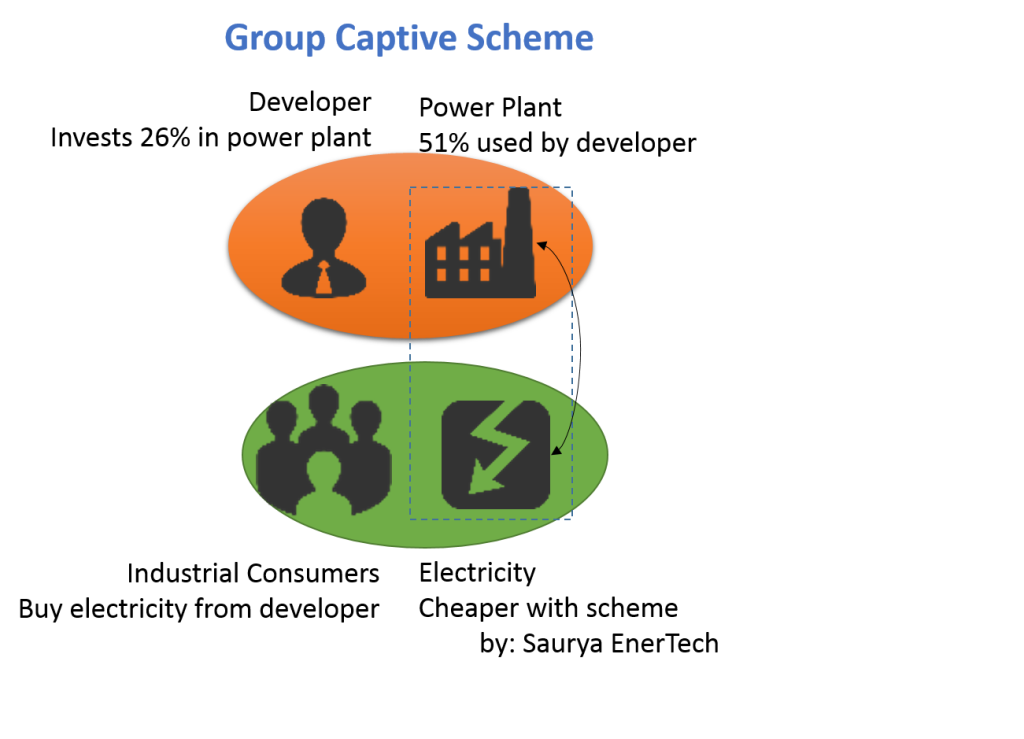Group Captive Power Scheme in India
Although introduced in 2005, this scheme seems to be catching the trend off late in India. Understand this group captive power scheme in depth with pros and cons below.
What is a Group Captive Power Scheme?
A group captive scheme is where someone develops a power plant for collective usage of many commercial consumers. The developer should have at least 26% of the equity and has to consume at least 51% of the power produced. The term “captive power scheme” was introduced in the Electricity Rule, 1995. The picture below describes how a group captive power scheme will work:

Group captive power scheme can be seen in section 5.5.25 and 5.5.26 of National Electricity Policy which outlines the creation of captive power plants by a group of people. Following is an excerpt from the policy:
A large number of captive and standby generating stations in India have surplus capacity that could be supplied to the grid continuously or during certain time periods. These plants offer a sizeable and potentially competitive capacity that could be harnessed for meeting demand for power. Under the Act, captive generators have access to licensees and would get access to consumers who are allowed open access. Grid inter-connections for captive generators shall be facilitated as per section 30 of the Act. This should be done on priority basis to enable captive generation to become available as distributed generation along the grid. Towards this end, non-conventional energy sources including co-generation could also play a role. Appropriate commercial arrangements would need to be instituted between licensees and the captive generators for harnessing of spare capacity energy from captive power plants.
– Source: Ministry of Power
What are the advantages of Group Captive Scheme?
- Cheaper price: This is the most important factor and the reason why it all works. Industrial tariffs tend to be higher than residential and it effects the profit maximization condition. This way, industries will get cheaper rate. Business Standard estimates the market rate to be around Rs 3/ unit while production cost to be around Rs 3.50/unit.
- Cross subsidy: By section 42 of the Electricity Act, 2003 the consumers of captive power scheme are exempt from paying cross subsidy charges.
- Power Cuts: In case of a power cut, industrial consumers face heavy productivity losses leading to financial losses. Group captive scheme, circumvents this frustrating problem entirely.
- State utility: The consumers in the group captive scheme no longer need to worry about bureaucratic utilities.
- Solar: This is the star of group captive scheme thanks to REC. More on this is mentioned below.
How will the Group Captive Power Scheme work?
Imagine Company A along with company B and company C decide to bring down their electricity costs. Collectively they make a power plant with 26% equity and decide to use about 51% of energy produced. Then they decide to sell the remaining 49% power to Company X, Y and Z. This makes the whole group part of the group captive power scheme.
Group Captive Power Scheme in Solar
Suppose the developer decides to make a Solar power plant for using the group captive scheme. Now, he not only gets the group captive scheme benefits but also gets to sell the REC (Renewable Energy Certificates) in open market or the IEX (Indian Energy Exchange).
More Information
Saurya EnerTech is a leading solar energy consultancy service in India and we have worked with multiple solar power plant projects both grid interactive and off grid. Reach out to us for engineering services you might need for your group captive solar power plant.
Author: Google +
Tags: Group Captive Solar in India, Captive Scheme Solar, Group Captive Power, Group Captive Advantages, Group Captive Disadvantages , Group Captive power


“In case of a power cut, industrial consumers face heavy productivity losses leading to financial losses. Group captive scheme, circumvents this frustrating problem entirely.”
Power cuts are usually due to a fault in the supply line to the end customer. Am I correct in saying that the above mentioned advantage would only be possible if the captive plant is supplying electricity directly to the industrial owner? Which, again is a proposition possible only for small power set ups. In the case of a Megawatt scale plant, the power would have to be routed through the grid and hence becomes vulnerable to all the possible failures the grid is subject to.
Partly correct, because: (a) the faults can occur in the distribution/transmission lines too (remember Unsymmetrical faults). And distribution system features these faults quite often. (b) Captive plants are generally connected directly to the consumers, mainly because they wish to avoid distribution system all together. However they still maintain connection with grid for contingency purpose for which they pay DISCOMs something called stand-by charges. (c) Now in this case since rest 49% (assuming) can be supplied to other consumers, usage of grid infrastructure is inevitable. But if interconnection is done at higher voltage levels then uncertainty can be minimized.